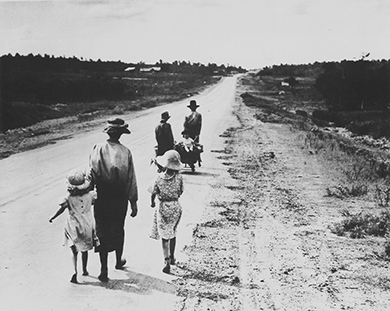| << Chapter < Page | Chapter >> Page > |
Another problem plaguing this relief effort was the disparity between large commercial farms, which received the largest payments and set the quotas, and the small family farms that felt no relief. Large farms often cut production by laying off sharecroppers or evicting tenant farmers, making the program even worse for them than for small farm owners. Their frustration led to the creation of the Southern Tenant Farmers Union (STFU), an interracial organization that sought to gain government relief for these most disenfranchised of farmers. The STFU organized, protested, and won its members some wage increases through the mid-1930s, but the overall plight of these workers remained dismal. As a result, many of them followed the thousands of Dust Bowl refugees to California ( [link] ).

And if the growers get in the way, we’re gonna roll right over them
We’re gonna roll right over them, we’re gonna roll right over them
And if the growers get in the way, we’re gonna roll right over them
We’re gonna roll this union on
—John Handcox, “Roll the Union On”
“Mean Things Happening in This Land,” “Roll the Union On,” and “Strike in Arkansas” are just a few of the folk songs written by John Handcox. A union organizer and STFU member, Handcox became the voice of the worker’s struggle, writing dozens of songs that have continued to be sung by labor activists and folk singers over the years. Handcox joined the STFU in 1935, and used his songs to rally others, stating, “I found out singing was more inspiring than talking . . . to get the attention of the people.”
Racially integrated and with active women members, the STFU was ahead of its time. Although criticized by other union leaders for its relationship with the Communist Party in creating the “Popular Front” for labor activism in 1934, the STFU succeeded in organizing strikes and bringing national attention to the issues that tenant farmers faced. While the programs Roosevelt put in place did not do enough to help these farmers, the STFU—and Handcox’s music—remains a relevant part of the country’s labor movement.
The AAA did succeed on some fronts. By the spring of 1934, farmers had formed over four thousand local committees, with more than three million farmers agreeing to participate. They signed individual contracts agreeing to take land out of production in return for government payments, and checks began to arrive by the end of 1934. For some farmers, especially those with large farms, the program spelled relief.
While Roosevelt hoped the AAA would help farms and farmers, he also sought aid for the beleaguered manufacturing sector. The Emergency Railroad Transportation Act created a national railroad office to encourage cooperation among different railroad companies, hoping to shore up an industry essential to the stability of the manufacturing sector, but one that had been devastated by mismanagement. More importantly, the NIRA suspended antitrust laws and allowed businesses and industries to work together in order to establish codes of fair competition, including issues of price setting and minimum wages. New Deal officials believed that allowing these collaborations would help industries stabilize prices and production levels in the face of competitive overproduction and declining profits; however, at the same time, many felt it important to protect workers from potentially unfair agreements.

Notification Switch
Would you like to follow the 'U.s. history' conversation and receive update notifications?